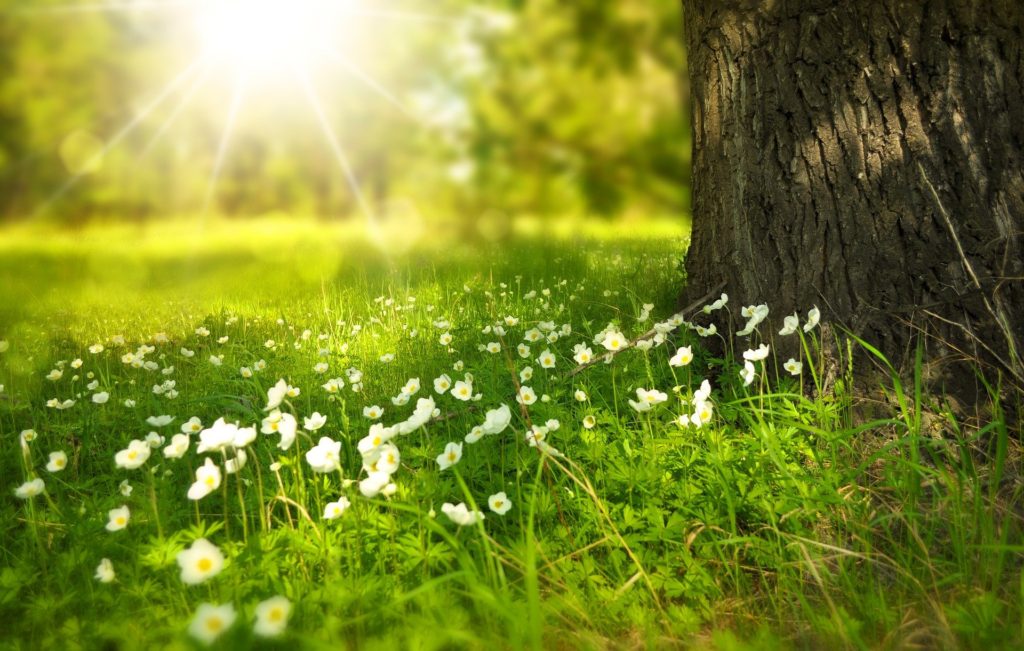Caring for trees during summer months is a little different than tree care during other times of the year. If all is going well, summer is often a very “hands off” season when it comes to taking care of your trees. However, if there are problems or health concerns in your trees, hot summer months can exacerbate these quickly and so must be dealt with as soon as possible.
Here are some of our favourite tips for easy summer tree care to make sure your property stays beautiful and healthy during even the hottest days of the summer.
Mulching
Mulch can help to protect the tree from heat during the summer. It is best to spread the mulch around the base of the tree to an even depth of 3 to 4 inches. Cover about a 5 foot circle around the tree to help protect the soil in the areas where roots may be near the surface.
Putting mulch around your tree during the summer helps to keep the soil moist and avoid excessive dehydration particularly during the sunniest, warmest months and in times of drought. It also works to protect the roots around the base of the trunk from temperature extremes.
When using mulch during the summer, ensure you do not spread too much of it too close to the trunk of the tree as here it can retain too much moisture. This can lead to pests, disease, and wood decay. Ensure you do not let the mulch touch the trunk and instead let it cover the soil surrounding it evenly.
Regular Watering
While we often think that nature can handle watering our trees for us, depending on the age of the tree and conditions in the summer, we may have to step in to help.
If a tree is newly planted, you should water it two or three times per week to keep the ground moist and help its roots grow deep, especially in harsher summer conditions.
For a young tree under two years old, using mulch to keep the soil moist is very helpful so the tree can expand its roots and find water without expunging too much effort. The soil should be kept moist by watering it for about 30 seconds with a hose. The soil should not be soggy.
Once a tree has reached two years old, it has likely taken root and can withstand a broader range of heat and weather conditions. However, in times of drought you may need to provide deep watering to reduce the stress on your tree.
Watch for Heat Stress
Heat stress can affect any tree depending on the conditions, but young trees are particularly vulnerable. Ensure newly planted trees receive shade to help them avoid heat stress.
The signs of heat stress on trees include drooping, wilting leaves, and yellowing of the leaves. If you see these symptoms appearing in your tree on a particularly hot day or during times of drought, give your tree sufficient water to help it recover. Knowing the signs of heat stress can help you respond faster and ensure you assist your trees faster when they need it.
Check for Pests
Even if a tree looks healthy, it may be attracting infestations or pests that might not be noticed until it’s too late. In the summer while spending time outside, regularly check your trees for signs of infestations or other pests that could be affecting their health.
Signs like clean borer holes, wounds in the bark, dripping sap, dead or dying branches, egg masses, or larva can indicate an infestation. Notably, the invasive species gypsy moth lays eggs in masses on trees that we can visually see and scrape off to prevent infestations. Finding evidence of an emerald ash borer infestation on one of your trees can help you take care of the issue quickly and perhaps save other trees in your neighbourhood.
Prune Smart
Pruning is typically recommended when the tree is dormant, like early spring before the tree begins to bud. However, it is important to know how to prune a tree in the summer if necessary for the health of the tree.
Pruning in the summer can be done for corrective reasons, like a clearly dead or dying limb that needs to be removed for safety reasons and to protect the rest of the tree. Sometimes, these dead or dying limbs are obvious and can be pruned in the summer easily by anyone. However, when these limbs are:
- Large or heavy;
- High in the tree canopy;
- The result of a disease or infestation;
…it is best to call a professional.
Storm Damage Protection
Summer storms can have immense gusts of wind, heavy rain, and lightning strikes that can wreak havoc on trees. Keep an eye on your trees during storms and afterwards, check for fallen limbs or other debris that may cause injury.
If you are concerned about the safety of your trees during summer storms or a tree is heavily damaged, contact a certified arborist for recommendations about next steps to lower your risk.
Get Tree Care this Summer from P & A
If you have any concerns about the health or safety of your trees this summer, P & A can make recommendations for treatment of diseases and infestations or for tips on how to take care of the specific species on your property.
With summer being the peak time in Ontario for home construction projects, keep in mind that these often require arborist reports when there are trees on the property. Municipalities want to ensure the health of community trees and urban forests as much as possible while construction work is being carried out during these hot months.
For all your tree care and arborist reporting needs this summer, contact P & A.
